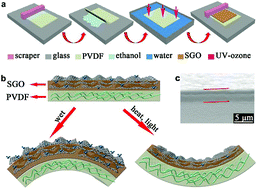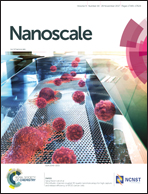A small graphene oxide sheet/polyvinylidene fluoride bilayer actuator with large and rapid responses to multiple stimuli†
Abstract
A high-performance actuator should be able to deliver large-shape deformations, fast actuations and sensitive responses to multiple stimuli. Here, we report such an actuator constructed from one layer of polyvinylidene fluoride (PVDF) with a high coefficient of thermal expansion (CTE), and another layer of small sheets of graphene oxide (SGO) with a negative CTE. The opposite deformations of both actuation layers make the SGO/PVDF bilayer actuator highly sensitive to the temperature stimulus with a large bending sensitivity of 1.5 cm−1 °C−1. Upon irradiation with 60 mW cm−2 infrared light, this SGO/PVDF bilayer actuator displayed an extremely rapid tip displacement rate of 140 mm s−1. Furthermore, this actuator can also sensitively respond to moisture because of its SGO layer, showing a curvature change from −22 to 13 cm−1 upon changing the relative humidity (RH) from 11% to 86%. This actuator can generate a contractile or relaxed stress 18 times that of mammalian skeletal muscle, under light irradiation or moisture with a response time as short as 1 s, being capable of lifting an object with a weight 80 times that of itself. Furthermore, it also showed excellent stability and repeatability.

- This article is part of the themed collection: Graphene Turns 15: Bio-implications and Bio-applications


 Please wait while we load your content...
Please wait while we load your content...